The Role of Systems Thinking in AI and Sustainability Challenges
VerifiedAdded on 2022/09/21
|10
|2992
|19
Essay
AI Summary
This essay explores the critical role of systems thinking in addressing sustainability challenges, with a specific focus on the wicked problem of gender bias in artificial intelligence. The paper begins by introducing systems thinking as a more effective approach than traditional methods, emphasizing the interconnectedness of system components. It then delves into the impact of AI, highlighting potential challenges such as the emergence of 'wicked problems' and the limitations of AI in solving human errors. The discussion examines how systems thinking, rooted in complexity theory, can help manage these issues by identifying and addressing the loops within problems. The essay further explores the concept of Complex Adaptive Systems (CAS) and how organizations can apply a systems mindset. It also discusses the potential for bias in AI algorithms and the importance of addressing these issues. The paper concludes by emphasizing the significance of systems thinking in improving cognitive human behavior to avoid AI-related problems and promoting shared understanding to establish collective understanding of the underlying factors related to the problem, ultimately supporting the development of more sustainable and equitable AI solutions.
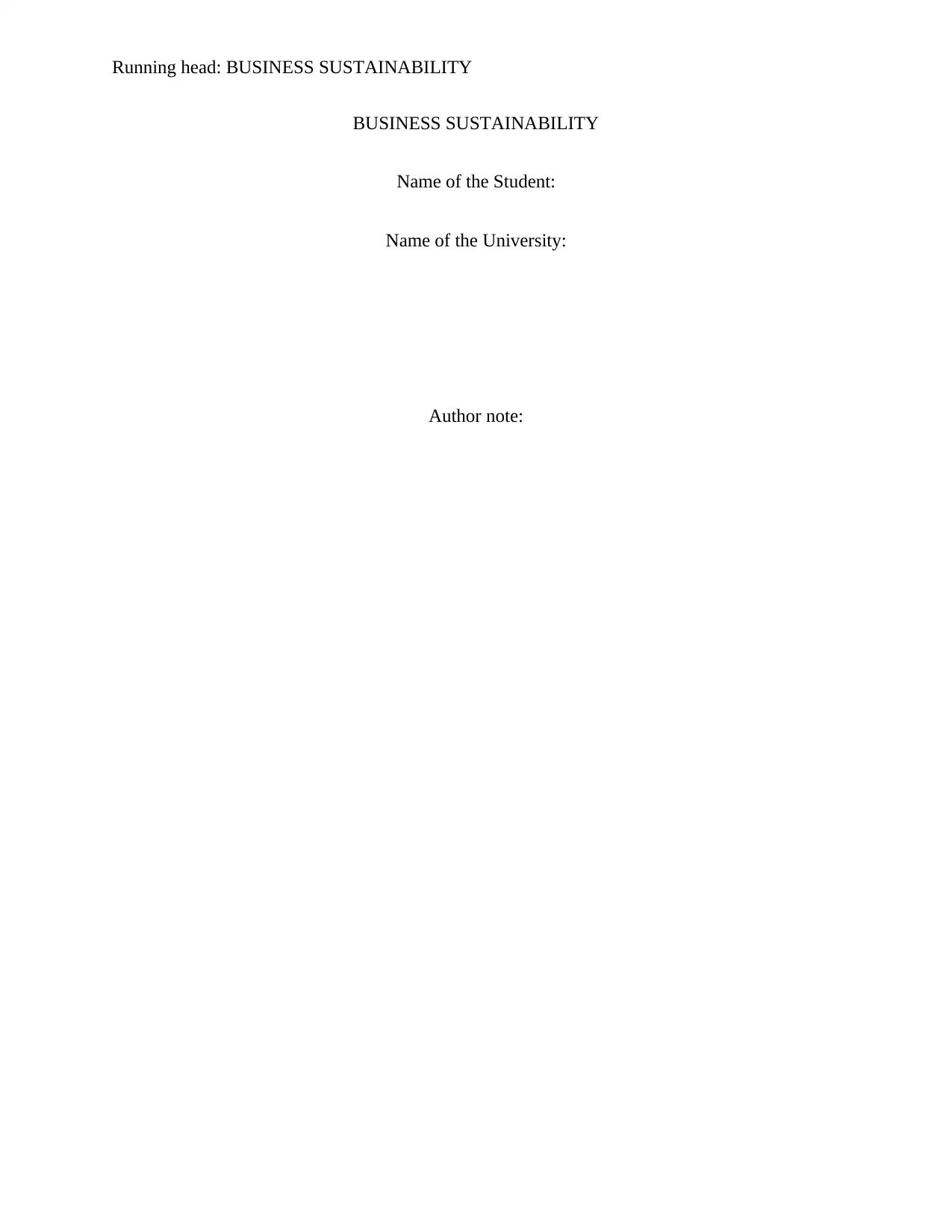
Running head: BUSINESS SUSTAINABILITY
BUSINESS SUSTAINABILITY
Name of the Student:
Name of the University:
Author note:
BUSINESS SUSTAINABILITY
Name of the Student:
Name of the University:
Author note:
Paraphrase This Document
Need a fresh take? Get an instant paraphrase of this document with our AI Paraphraser
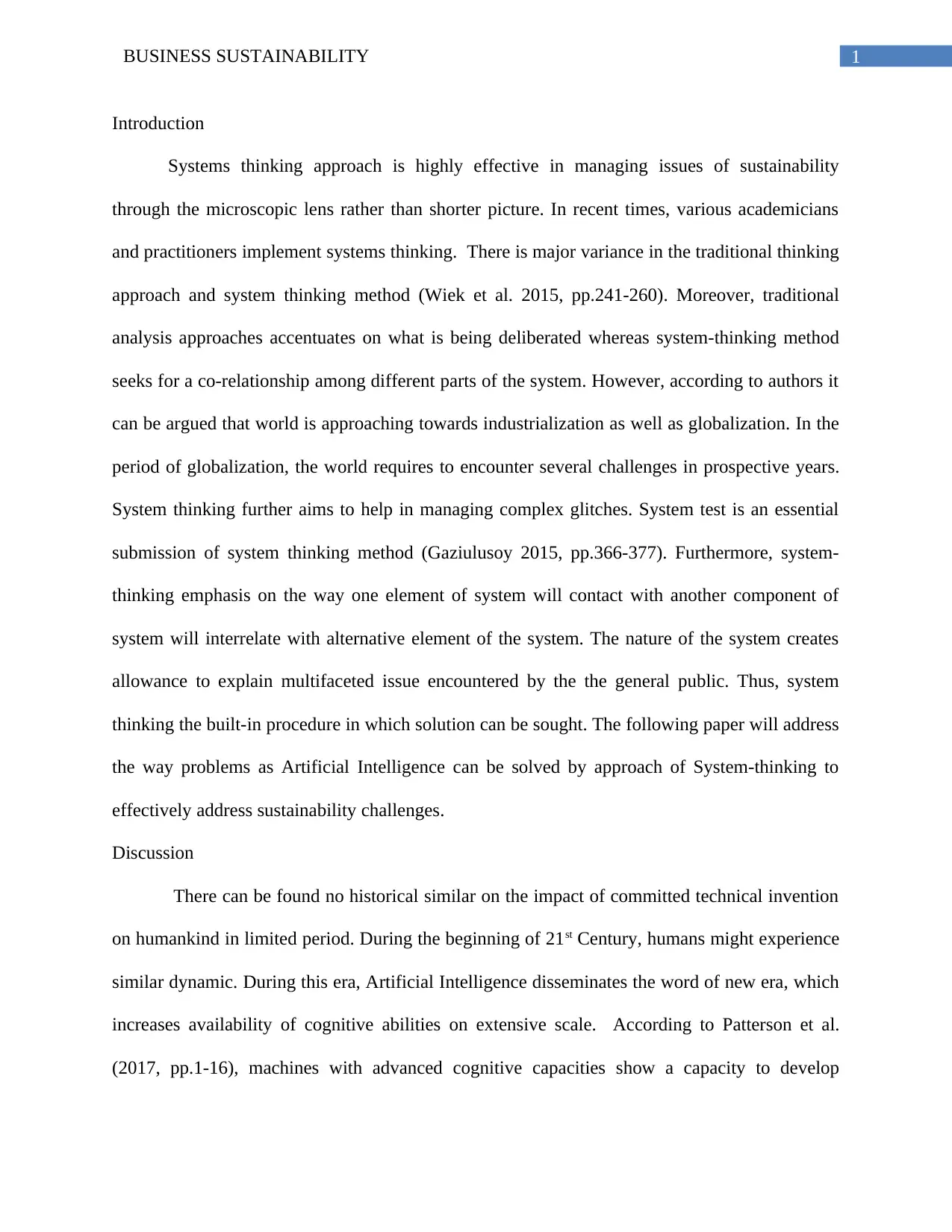
1BUSINESS SUSTAINABILITY
Introduction
Systems thinking approach is highly effective in managing issues of sustainability
through the microscopic lens rather than shorter picture. In recent times, various academicians
and practitioners implement systems thinking. There is major variance in the traditional thinking
approach and system thinking method (Wiek et al. 2015, pp.241-260). Moreover, traditional
analysis approaches accentuates on what is being deliberated whereas system-thinking method
seeks for a co-relationship among different parts of the system. However, according to authors it
can be argued that world is approaching towards industrialization as well as globalization. In the
period of globalization, the world requires to encounter several challenges in prospective years.
System thinking further aims to help in managing complex glitches. System test is an essential
submission of system thinking method (Gaziulusoy 2015, pp.366-377). Furthermore, system-
thinking emphasis on the way one element of system will contact with another component of
system will interrelate with alternative element of the system. The nature of the system creates
allowance to explain multifaceted issue encountered by the the general public. Thus, system
thinking the built-in procedure in which solution can be sought. The following paper will address
the way problems as Artificial Intelligence can be solved by approach of System-thinking to
effectively address sustainability challenges.
Discussion
There can be found no historical similar on the impact of committed technical invention
on humankind in limited period. During the beginning of 21st Century, humans might experience
similar dynamic. During this era, Artificial Intelligence disseminates the word of new era, which
increases availability of cognitive abilities on extensive scale. According to Patterson et al.
(2017, pp.1-16), machines with advanced cognitive capacities show a capacity to develop
Introduction
Systems thinking approach is highly effective in managing issues of sustainability
through the microscopic lens rather than shorter picture. In recent times, various academicians
and practitioners implement systems thinking. There is major variance in the traditional thinking
approach and system thinking method (Wiek et al. 2015, pp.241-260). Moreover, traditional
analysis approaches accentuates on what is being deliberated whereas system-thinking method
seeks for a co-relationship among different parts of the system. However, according to authors it
can be argued that world is approaching towards industrialization as well as globalization. In the
period of globalization, the world requires to encounter several challenges in prospective years.
System thinking further aims to help in managing complex glitches. System test is an essential
submission of system thinking method (Gaziulusoy 2015, pp.366-377). Furthermore, system-
thinking emphasis on the way one element of system will contact with another component of
system will interrelate with alternative element of the system. The nature of the system creates
allowance to explain multifaceted issue encountered by the the general public. Thus, system
thinking the built-in procedure in which solution can be sought. The following paper will address
the way problems as Artificial Intelligence can be solved by approach of System-thinking to
effectively address sustainability challenges.
Discussion
There can be found no historical similar on the impact of committed technical invention
on humankind in limited period. During the beginning of 21st Century, humans might experience
similar dynamic. During this era, Artificial Intelligence disseminates the word of new era, which
increases availability of cognitive abilities on extensive scale. According to Patterson et al.
(2017, pp.1-16), machines with advanced cognitive capacities show a capacity to develop
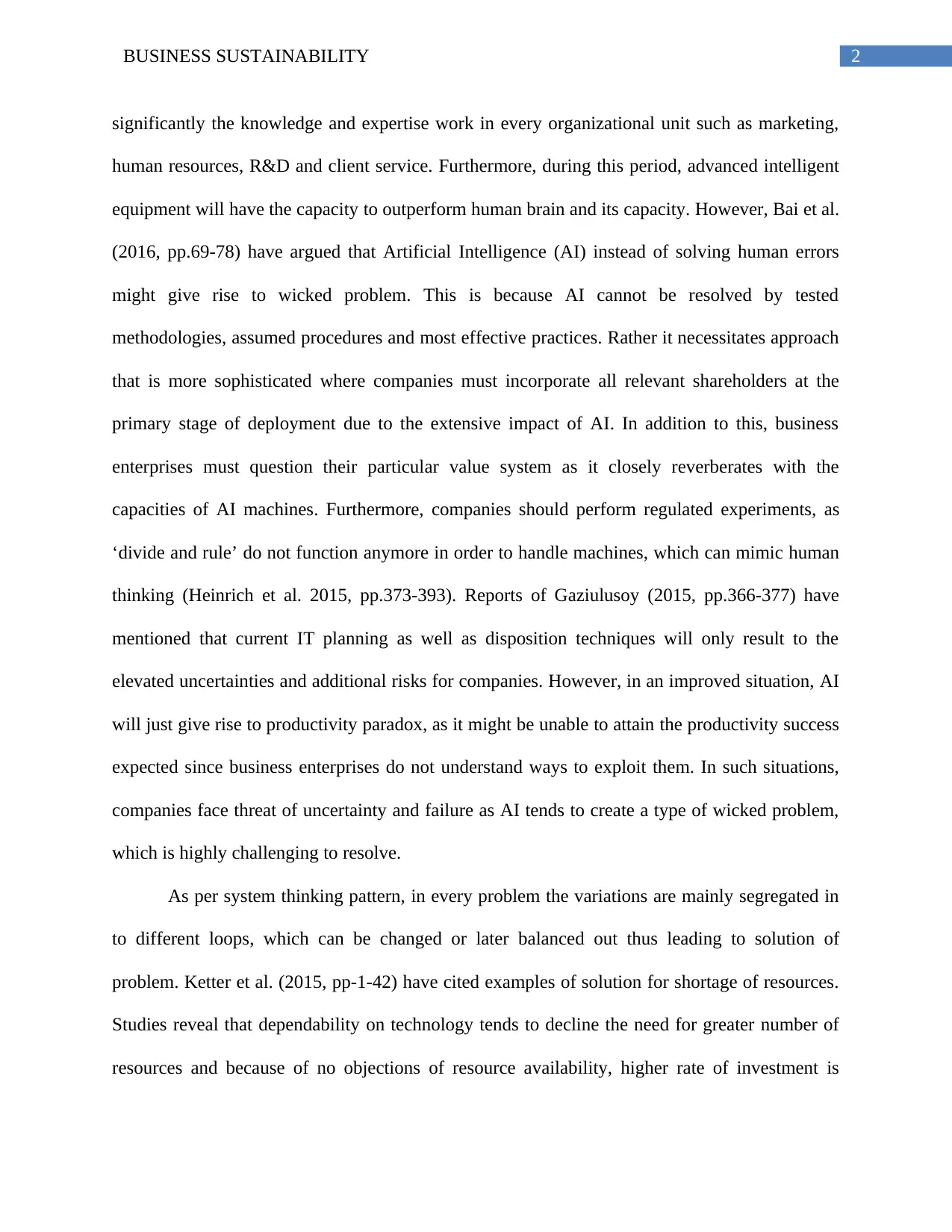
2BUSINESS SUSTAINABILITY
significantly the knowledge and expertise work in every organizational unit such as marketing,
human resources, R&D and client service. Furthermore, during this period, advanced intelligent
equipment will have the capacity to outperform human brain and its capacity. However, Bai et al.
(2016, pp.69-78) have argued that Artificial Intelligence (AI) instead of solving human errors
might give rise to wicked problem. This is because AI cannot be resolved by tested
methodologies, assumed procedures and most effective practices. Rather it necessitates approach
that is more sophisticated where companies must incorporate all relevant shareholders at the
primary stage of deployment due to the extensive impact of AI. In addition to this, business
enterprises must question their particular value system as it closely reverberates with the
capacities of AI machines. Furthermore, companies should perform regulated experiments, as
‘divide and rule’ do not function anymore in order to handle machines, which can mimic human
thinking (Heinrich et al. 2015, pp.373-393). Reports of Gaziulusoy (2015, pp.366-377) have
mentioned that current IT planning as well as disposition techniques will only result to the
elevated uncertainties and additional risks for companies. However, in an improved situation, AI
will just give rise to productivity paradox, as it might be unable to attain the productivity success
expected since business enterprises do not understand ways to exploit them. In such situations,
companies face threat of uncertainty and failure as AI tends to create a type of wicked problem,
which is highly challenging to resolve.
As per system thinking pattern, in every problem the variations are mainly segregated in
to different loops, which can be changed or later balanced out thus leading to solution of
problem. Ketter et al. (2015, pp-1-42) have cited examples of solution for shortage of resources.
Studies reveal that dependability on technology tends to decline the need for greater number of
resources and because of no objections of resource availability, higher rate of investment is
significantly the knowledge and expertise work in every organizational unit such as marketing,
human resources, R&D and client service. Furthermore, during this period, advanced intelligent
equipment will have the capacity to outperform human brain and its capacity. However, Bai et al.
(2016, pp.69-78) have argued that Artificial Intelligence (AI) instead of solving human errors
might give rise to wicked problem. This is because AI cannot be resolved by tested
methodologies, assumed procedures and most effective practices. Rather it necessitates approach
that is more sophisticated where companies must incorporate all relevant shareholders at the
primary stage of deployment due to the extensive impact of AI. In addition to this, business
enterprises must question their particular value system as it closely reverberates with the
capacities of AI machines. Furthermore, companies should perform regulated experiments, as
‘divide and rule’ do not function anymore in order to handle machines, which can mimic human
thinking (Heinrich et al. 2015, pp.373-393). Reports of Gaziulusoy (2015, pp.366-377) have
mentioned that current IT planning as well as disposition techniques will only result to the
elevated uncertainties and additional risks for companies. However, in an improved situation, AI
will just give rise to productivity paradox, as it might be unable to attain the productivity success
expected since business enterprises do not understand ways to exploit them. In such situations,
companies face threat of uncertainty and failure as AI tends to create a type of wicked problem,
which is highly challenging to resolve.
As per system thinking pattern, in every problem the variations are mainly segregated in
to different loops, which can be changed or later balanced out thus leading to solution of
problem. Ketter et al. (2015, pp-1-42) have cited examples of solution for shortage of resources.
Studies reveal that dependability on technology tends to decline the need for greater number of
resources and because of no objections of resource availability, higher rate of investment is
⊘ This is a preview!⊘
Do you want full access?
Subscribe today to unlock all pages.

Trusted by 1+ million students worldwide
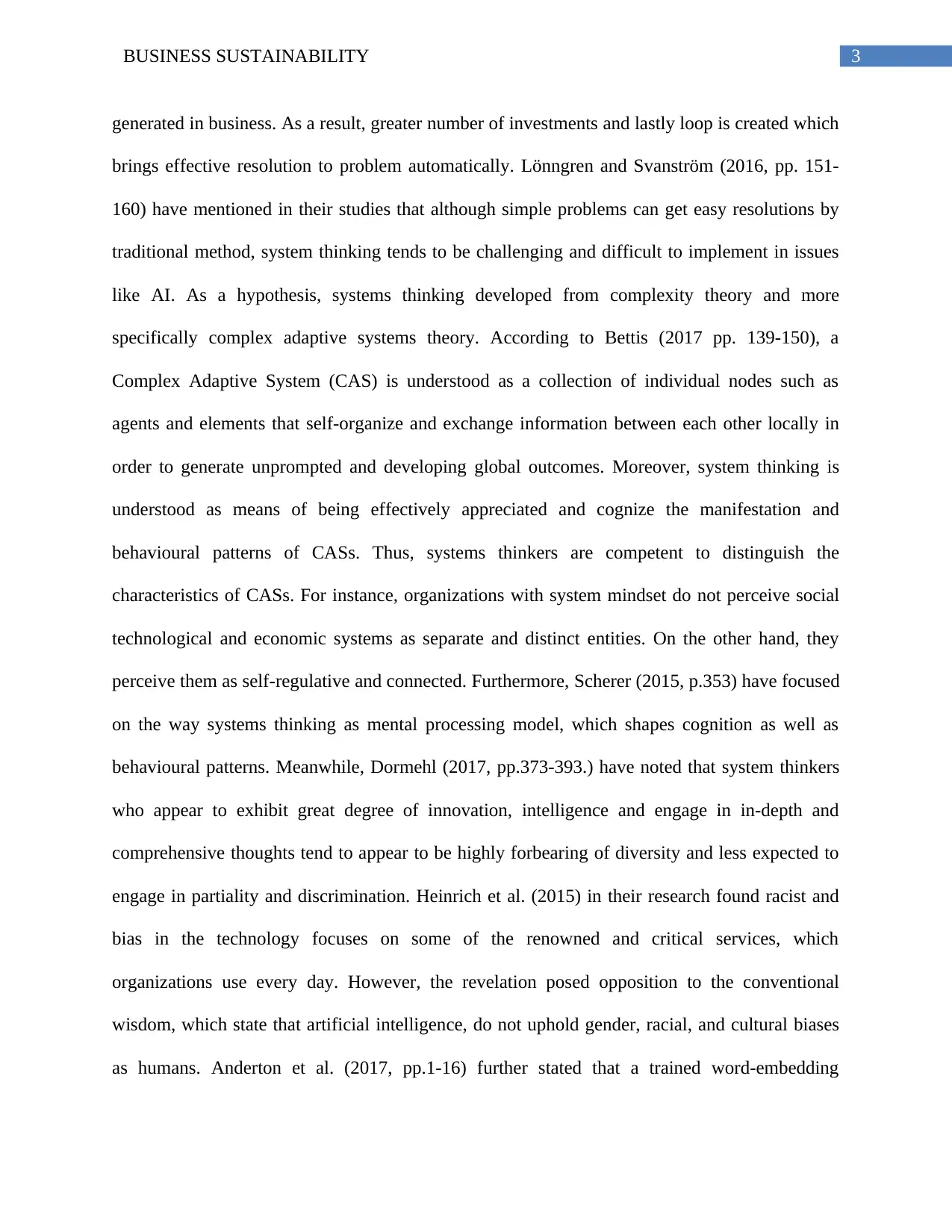
3BUSINESS SUSTAINABILITY
generated in business. As a result, greater number of investments and lastly loop is created which
brings effective resolution to problem automatically. Lönngren and Svanström (2016, pp. 151-
160) have mentioned in their studies that although simple problems can get easy resolutions by
traditional method, system thinking tends to be challenging and difficult to implement in issues
like AI. As a hypothesis, systems thinking developed from complexity theory and more
specifically complex adaptive systems theory. According to Bettis (2017 pp. 139-150), a
Complex Adaptive System (CAS) is understood as a collection of individual nodes such as
agents and elements that self-organize and exchange information between each other locally in
order to generate unprompted and developing global outcomes. Moreover, system thinking is
understood as means of being effectively appreciated and cognize the manifestation and
behavioural patterns of CASs. Thus, systems thinkers are competent to distinguish the
characteristics of CASs. For instance, organizations with system mindset do not perceive social
technological and economic systems as separate and distinct entities. On the other hand, they
perceive them as self-regulative and connected. Furthermore, Scherer (2015, p.353) have focused
on the way systems thinking as mental processing model, which shapes cognition as well as
behavioural patterns. Meanwhile, Dormehl (2017, pp.373-393.) have noted that system thinkers
who appear to exhibit great degree of innovation, intelligence and engage in in-depth and
comprehensive thoughts tend to appear to be highly forbearing of diversity and less expected to
engage in partiality and discrimination. Heinrich et al. (2015) in their research found racist and
bias in the technology focuses on some of the renowned and critical services, which
organizations use every day. However, the revelation posed opposition to the conventional
wisdom, which state that artificial intelligence, do not uphold gender, racial, and cultural biases
as humans. Anderton et al. (2017, pp.1-16) further stated that a trained word-embedding
generated in business. As a result, greater number of investments and lastly loop is created which
brings effective resolution to problem automatically. Lönngren and Svanström (2016, pp. 151-
160) have mentioned in their studies that although simple problems can get easy resolutions by
traditional method, system thinking tends to be challenging and difficult to implement in issues
like AI. As a hypothesis, systems thinking developed from complexity theory and more
specifically complex adaptive systems theory. According to Bettis (2017 pp. 139-150), a
Complex Adaptive System (CAS) is understood as a collection of individual nodes such as
agents and elements that self-organize and exchange information between each other locally in
order to generate unprompted and developing global outcomes. Moreover, system thinking is
understood as means of being effectively appreciated and cognize the manifestation and
behavioural patterns of CASs. Thus, systems thinkers are competent to distinguish the
characteristics of CASs. For instance, organizations with system mindset do not perceive social
technological and economic systems as separate and distinct entities. On the other hand, they
perceive them as self-regulative and connected. Furthermore, Scherer (2015, p.353) have focused
on the way systems thinking as mental processing model, which shapes cognition as well as
behavioural patterns. Meanwhile, Dormehl (2017, pp.373-393.) have noted that system thinkers
who appear to exhibit great degree of innovation, intelligence and engage in in-depth and
comprehensive thoughts tend to appear to be highly forbearing of diversity and less expected to
engage in partiality and discrimination. Heinrich et al. (2015) in their research found racist and
bias in the technology focuses on some of the renowned and critical services, which
organizations use every day. However, the revelation posed opposition to the conventional
wisdom, which state that artificial intelligence, do not uphold gender, racial, and cultural biases
as humans. Anderton et al. (2017, pp.1-16) further stated that a trained word-embedding
Paraphrase This Document
Need a fresh take? Get an instant paraphrase of this document with our AI Paraphraser
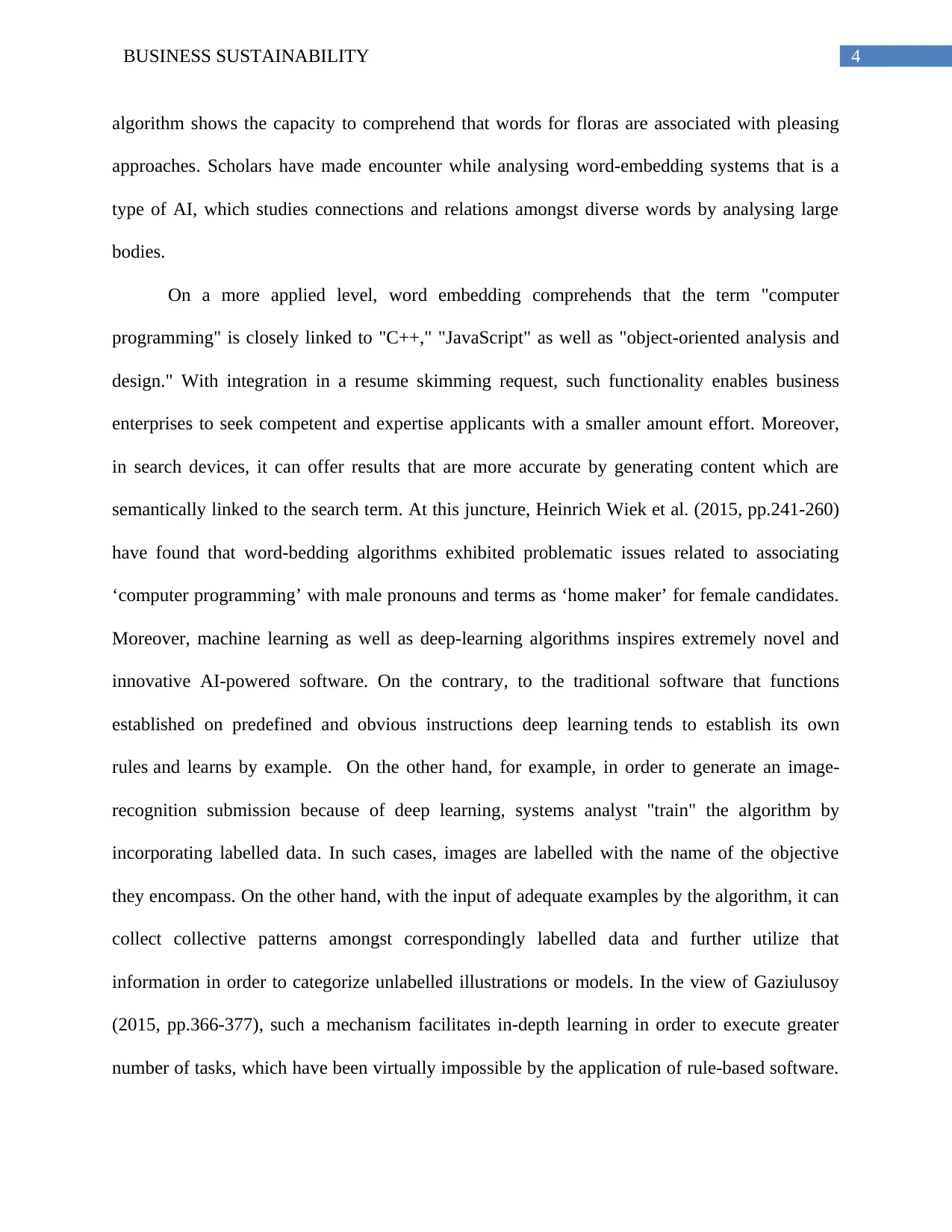
4BUSINESS SUSTAINABILITY
algorithm shows the capacity to comprehend that words for floras are associated with pleasing
approaches. Scholars have made encounter while analysing word-embedding systems that is a
type of AI, which studies connections and relations amongst diverse words by analysing large
bodies.
On a more applied level, word embedding comprehends that the term "computer
programming" is closely linked to "C++," "JavaScript" as well as "object-oriented analysis and
design." With integration in a resume skimming request, such functionality enables business
enterprises to seek competent and expertise applicants with a smaller amount effort. Moreover,
in search devices, it can offer results that are more accurate by generating content which are
semantically linked to the search term. At this juncture, Heinrich Wiek et al. (2015, pp.241-260)
have found that word-bedding algorithms exhibited problematic issues related to associating
‘computer programming’ with male pronouns and terms as ‘home maker’ for female candidates.
Moreover, machine learning as well as deep-learning algorithms inspires extremely novel and
innovative AI-powered software. On the contrary, to the traditional software that functions
established on predefined and obvious instructions deep learning tends to establish its own
rules and learns by example. On the other hand, for example, in order to generate an image-
recognition submission because of deep learning, systems analyst "train" the algorithm by
incorporating labelled data. In such cases, images are labelled with the name of the objective
they encompass. On the other hand, with the input of adequate examples by the algorithm, it can
collect collective patterns amongst correspondingly labelled data and further utilize that
information in order to categorize unlabelled illustrations or models. In the view of Gaziulusoy
(2015, pp.366-377), such a mechanism facilitates in-depth learning in order to execute greater
number of tasks, which have been virtually impossible by the application of rule-based software.
algorithm shows the capacity to comprehend that words for floras are associated with pleasing
approaches. Scholars have made encounter while analysing word-embedding systems that is a
type of AI, which studies connections and relations amongst diverse words by analysing large
bodies.
On a more applied level, word embedding comprehends that the term "computer
programming" is closely linked to "C++," "JavaScript" as well as "object-oriented analysis and
design." With integration in a resume skimming request, such functionality enables business
enterprises to seek competent and expertise applicants with a smaller amount effort. Moreover,
in search devices, it can offer results that are more accurate by generating content which are
semantically linked to the search term. At this juncture, Heinrich Wiek et al. (2015, pp.241-260)
have found that word-bedding algorithms exhibited problematic issues related to associating
‘computer programming’ with male pronouns and terms as ‘home maker’ for female candidates.
Moreover, machine learning as well as deep-learning algorithms inspires extremely novel and
innovative AI-powered software. On the contrary, to the traditional software that functions
established on predefined and obvious instructions deep learning tends to establish its own
rules and learns by example. On the other hand, for example, in order to generate an image-
recognition submission because of deep learning, systems analyst "train" the algorithm by
incorporating labelled data. In such cases, images are labelled with the name of the objective
they encompass. On the other hand, with the input of adequate examples by the algorithm, it can
collect collective patterns amongst correspondingly labelled data and further utilize that
information in order to categorize unlabelled illustrations or models. In the view of Gaziulusoy
(2015, pp.366-377), such a mechanism facilitates in-depth learning in order to execute greater
number of tasks, which have been virtually impossible by the application of rule-based software.
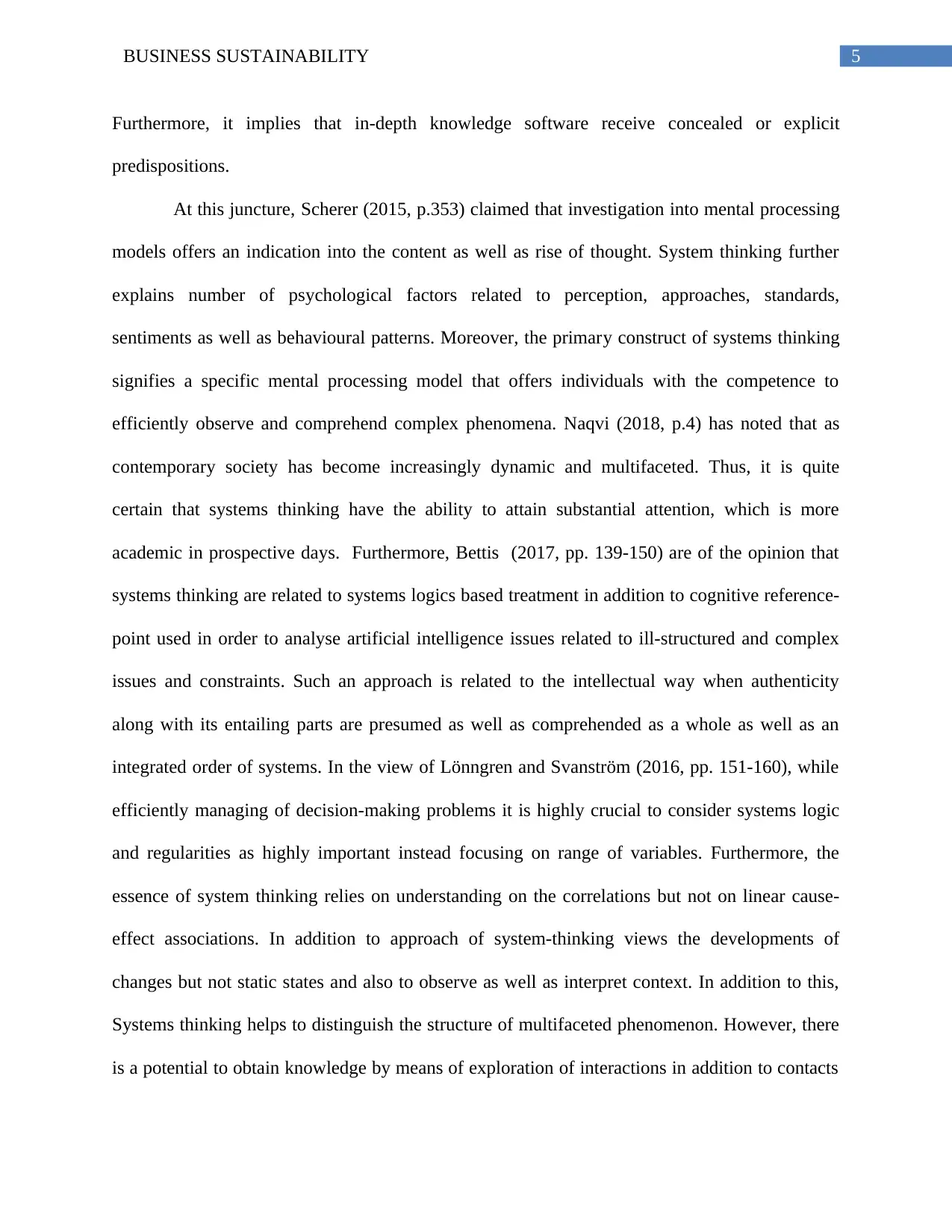
5BUSINESS SUSTAINABILITY
Furthermore, it implies that in-depth knowledge software receive concealed or explicit
predispositions.
At this juncture, Scherer (2015, p.353) claimed that investigation into mental processing
models offers an indication into the content as well as rise of thought. System thinking further
explains number of psychological factors related to perception, approaches, standards,
sentiments as well as behavioural patterns. Moreover, the primary construct of systems thinking
signifies a specific mental processing model that offers individuals with the competence to
efficiently observe and comprehend complex phenomena. Naqvi (2018, p.4) has noted that as
contemporary society has become increasingly dynamic and multifaceted. Thus, it is quite
certain that systems thinking have the ability to attain substantial attention, which is more
academic in prospective days. Furthermore, Bettis (2017, pp. 139-150) are of the opinion that
systems thinking are related to systems logics based treatment in addition to cognitive reference-
point used in order to analyse artificial intelligence issues related to ill-structured and complex
issues and constraints. Such an approach is related to the intellectual way when authenticity
along with its entailing parts are presumed as well as comprehended as a whole as well as an
integrated order of systems. In the view of Lönngren and Svanström (2016, pp. 151-160), while
efficiently managing of decision-making problems it is highly crucial to consider systems logic
and regularities as highly important instead focusing on range of variables. Furthermore, the
essence of system thinking relies on understanding on the correlations but not on linear cause-
effect associations. In addition to approach of system-thinking views the developments of
changes but not static states and also to observe as well as interpret context. In addition to this,
Systems thinking helps to distinguish the structure of multifaceted phenomenon. However, there
is a potential to obtain knowledge by means of exploration of interactions in addition to contacts
Furthermore, it implies that in-depth knowledge software receive concealed or explicit
predispositions.
At this juncture, Scherer (2015, p.353) claimed that investigation into mental processing
models offers an indication into the content as well as rise of thought. System thinking further
explains number of psychological factors related to perception, approaches, standards,
sentiments as well as behavioural patterns. Moreover, the primary construct of systems thinking
signifies a specific mental processing model that offers individuals with the competence to
efficiently observe and comprehend complex phenomena. Naqvi (2018, p.4) has noted that as
contemporary society has become increasingly dynamic and multifaceted. Thus, it is quite
certain that systems thinking have the ability to attain substantial attention, which is more
academic in prospective days. Furthermore, Bettis (2017, pp. 139-150) are of the opinion that
systems thinking are related to systems logics based treatment in addition to cognitive reference-
point used in order to analyse artificial intelligence issues related to ill-structured and complex
issues and constraints. Such an approach is related to the intellectual way when authenticity
along with its entailing parts are presumed as well as comprehended as a whole as well as an
integrated order of systems. In the view of Lönngren and Svanström (2016, pp. 151-160), while
efficiently managing of decision-making problems it is highly crucial to consider systems logic
and regularities as highly important instead focusing on range of variables. Furthermore, the
essence of system thinking relies on understanding on the correlations but not on linear cause-
effect associations. In addition to approach of system-thinking views the developments of
changes but not static states and also to observe as well as interpret context. In addition to this,
Systems thinking helps to distinguish the structure of multifaceted phenomenon. However, there
is a potential to obtain knowledge by means of exploration of interactions in addition to contacts
⊘ This is a preview!⊘
Do you want full access?
Subscribe today to unlock all pages.

Trusted by 1+ million students worldwide
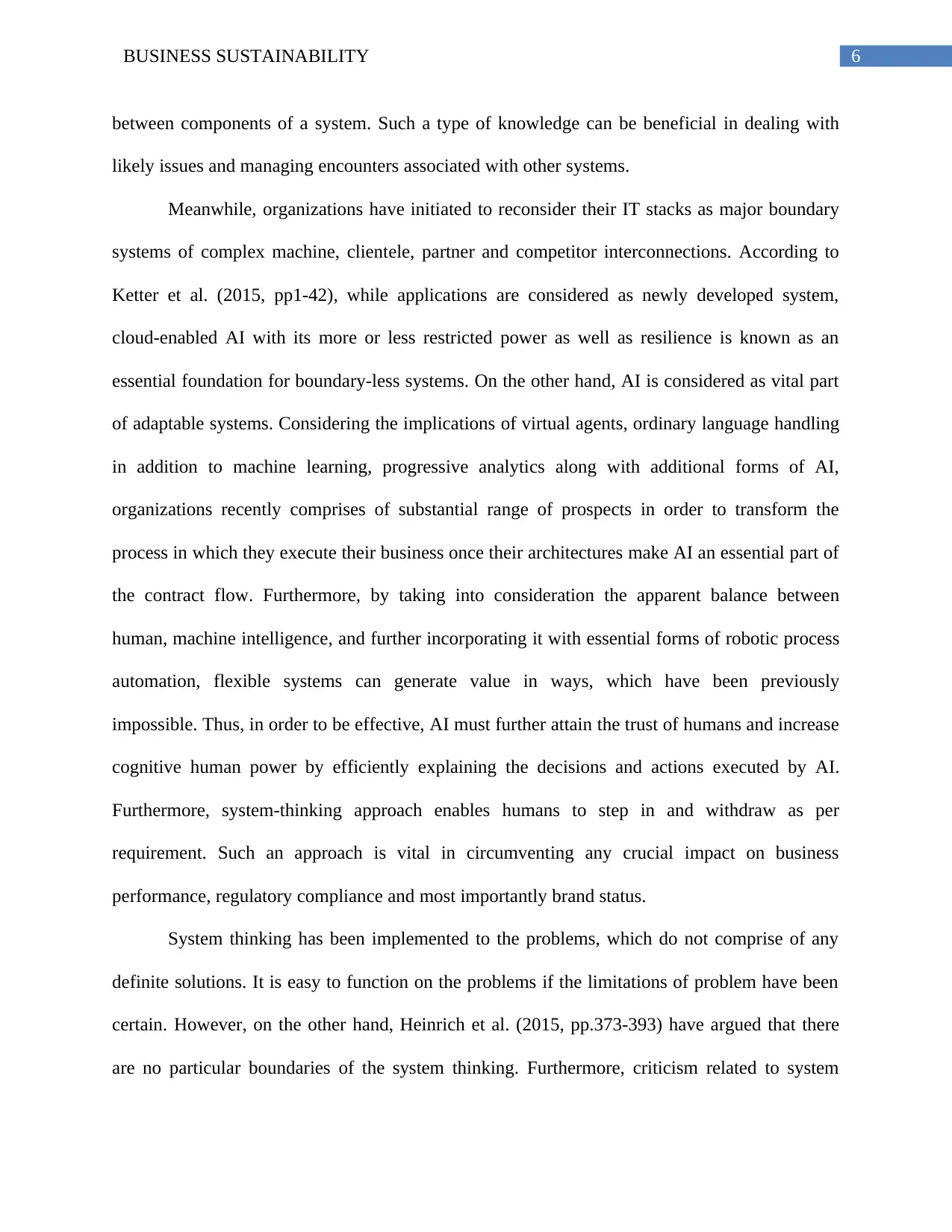
6BUSINESS SUSTAINABILITY
between components of a system. Such a type of knowledge can be beneficial in dealing with
likely issues and managing encounters associated with other systems.
Meanwhile, organizations have initiated to reconsider their IT stacks as major boundary
systems of complex machine, clientele, partner and competitor interconnections. According to
Ketter et al. (2015, pp1-42), while applications are considered as newly developed system,
cloud-enabled AI with its more or less restricted power as well as resilience is known as an
essential foundation for boundary-less systems. On the other hand, AI is considered as vital part
of adaptable systems. Considering the implications of virtual agents, ordinary language handling
in addition to machine learning, progressive analytics along with additional forms of AI,
organizations recently comprises of substantial range of prospects in order to transform the
process in which they execute their business once their architectures make AI an essential part of
the contract flow. Furthermore, by taking into consideration the apparent balance between
human, machine intelligence, and further incorporating it with essential forms of robotic process
automation, flexible systems can generate value in ways, which have been previously
impossible. Thus, in order to be effective, AI must further attain the trust of humans and increase
cognitive human power by efficiently explaining the decisions and actions executed by AI.
Furthermore, system-thinking approach enables humans to step in and withdraw as per
requirement. Such an approach is vital in circumventing any crucial impact on business
performance, regulatory compliance and most importantly brand status.
System thinking has been implemented to the problems, which do not comprise of any
definite solutions. It is easy to function on the problems if the limitations of problem have been
certain. However, on the other hand, Heinrich et al. (2015, pp.373-393) have argued that there
are no particular boundaries of the system thinking. Furthermore, criticism related to system
between components of a system. Such a type of knowledge can be beneficial in dealing with
likely issues and managing encounters associated with other systems.
Meanwhile, organizations have initiated to reconsider their IT stacks as major boundary
systems of complex machine, clientele, partner and competitor interconnections. According to
Ketter et al. (2015, pp1-42), while applications are considered as newly developed system,
cloud-enabled AI with its more or less restricted power as well as resilience is known as an
essential foundation for boundary-less systems. On the other hand, AI is considered as vital part
of adaptable systems. Considering the implications of virtual agents, ordinary language handling
in addition to machine learning, progressive analytics along with additional forms of AI,
organizations recently comprises of substantial range of prospects in order to transform the
process in which they execute their business once their architectures make AI an essential part of
the contract flow. Furthermore, by taking into consideration the apparent balance between
human, machine intelligence, and further incorporating it with essential forms of robotic process
automation, flexible systems can generate value in ways, which have been previously
impossible. Thus, in order to be effective, AI must further attain the trust of humans and increase
cognitive human power by efficiently explaining the decisions and actions executed by AI.
Furthermore, system-thinking approach enables humans to step in and withdraw as per
requirement. Such an approach is vital in circumventing any crucial impact on business
performance, regulatory compliance and most importantly brand status.
System thinking has been implemented to the problems, which do not comprise of any
definite solutions. It is easy to function on the problems if the limitations of problem have been
certain. However, on the other hand, Heinrich et al. (2015, pp.373-393) have argued that there
are no particular boundaries of the system thinking. Furthermore, criticism related to system
Paraphrase This Document
Need a fresh take? Get an instant paraphrase of this document with our AI Paraphraser
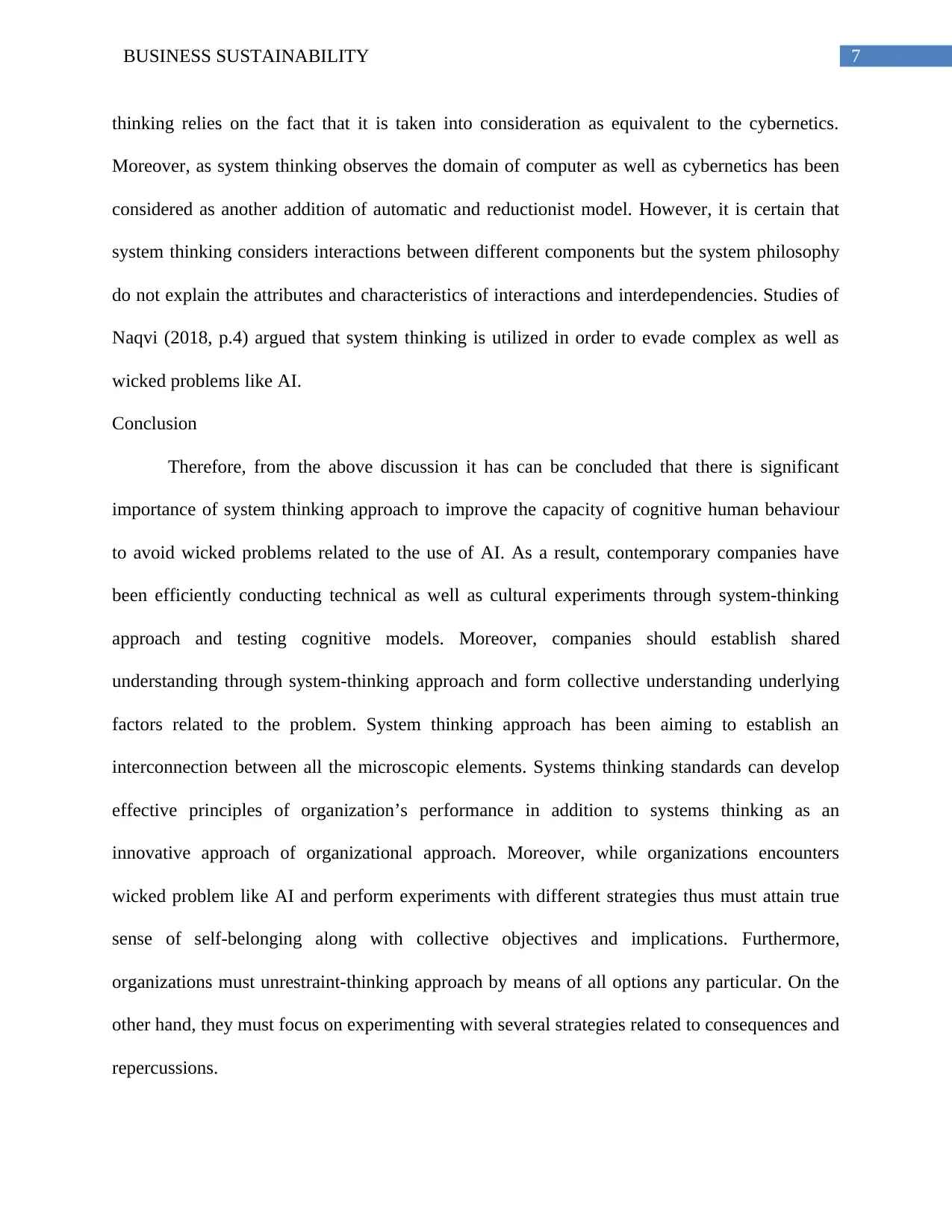
7BUSINESS SUSTAINABILITY
thinking relies on the fact that it is taken into consideration as equivalent to the cybernetics.
Moreover, as system thinking observes the domain of computer as well as cybernetics has been
considered as another addition of automatic and reductionist model. However, it is certain that
system thinking considers interactions between different components but the system philosophy
do not explain the attributes and characteristics of interactions and interdependencies. Studies of
Naqvi (2018, p.4) argued that system thinking is utilized in order to evade complex as well as
wicked problems like AI.
Conclusion
Therefore, from the above discussion it has can be concluded that there is significant
importance of system thinking approach to improve the capacity of cognitive human behaviour
to avoid wicked problems related to the use of AI. As a result, contemporary companies have
been efficiently conducting technical as well as cultural experiments through system-thinking
approach and testing cognitive models. Moreover, companies should establish shared
understanding through system-thinking approach and form collective understanding underlying
factors related to the problem. System thinking approach has been aiming to establish an
interconnection between all the microscopic elements. Systems thinking standards can develop
effective principles of organization’s performance in addition to systems thinking as an
innovative approach of organizational approach. Moreover, while organizations encounters
wicked problem like AI and perform experiments with different strategies thus must attain true
sense of self-belonging along with collective objectives and implications. Furthermore,
organizations must unrestraint-thinking approach by means of all options any particular. On the
other hand, they must focus on experimenting with several strategies related to consequences and
repercussions.
thinking relies on the fact that it is taken into consideration as equivalent to the cybernetics.
Moreover, as system thinking observes the domain of computer as well as cybernetics has been
considered as another addition of automatic and reductionist model. However, it is certain that
system thinking considers interactions between different components but the system philosophy
do not explain the attributes and characteristics of interactions and interdependencies. Studies of
Naqvi (2018, p.4) argued that system thinking is utilized in order to evade complex as well as
wicked problems like AI.
Conclusion
Therefore, from the above discussion it has can be concluded that there is significant
importance of system thinking approach to improve the capacity of cognitive human behaviour
to avoid wicked problems related to the use of AI. As a result, contemporary companies have
been efficiently conducting technical as well as cultural experiments through system-thinking
approach and testing cognitive models. Moreover, companies should establish shared
understanding through system-thinking approach and form collective understanding underlying
factors related to the problem. System thinking approach has been aiming to establish an
interconnection between all the microscopic elements. Systems thinking standards can develop
effective principles of organization’s performance in addition to systems thinking as an
innovative approach of organizational approach. Moreover, while organizations encounters
wicked problem like AI and perform experiments with different strategies thus must attain true
sense of self-belonging along with collective objectives and implications. Furthermore,
organizations must unrestraint-thinking approach by means of all options any particular. On the
other hand, they must focus on experimenting with several strategies related to consequences and
repercussions.
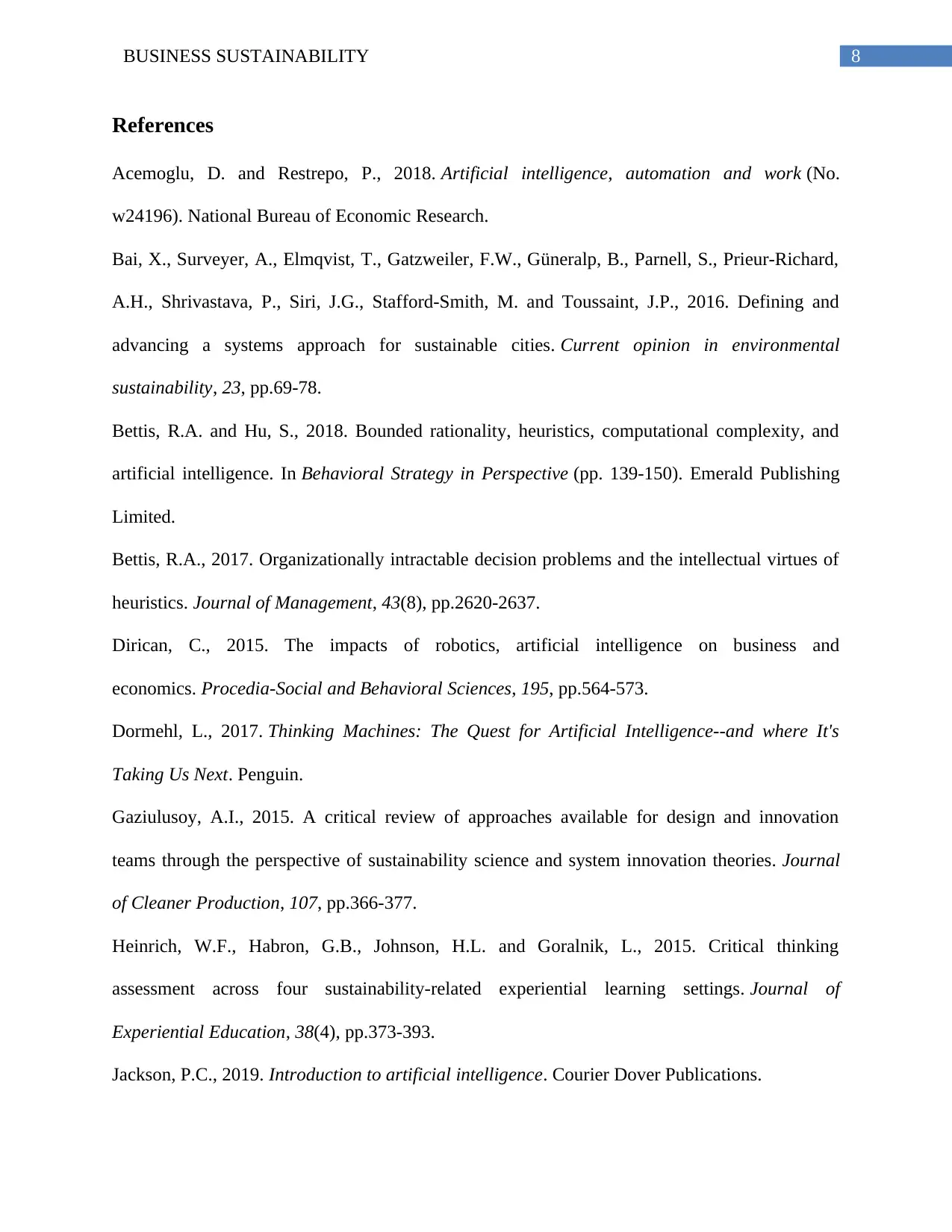
8BUSINESS SUSTAINABILITY
References
Acemoglu, D. and Restrepo, P., 2018. Artificial intelligence, automation and work (No.
w24196). National Bureau of Economic Research.
Bai, X., Surveyer, A., Elmqvist, T., Gatzweiler, F.W., Güneralp, B., Parnell, S., Prieur-Richard,
A.H., Shrivastava, P., Siri, J.G., Stafford-Smith, M. and Toussaint, J.P., 2016. Defining and
advancing a systems approach for sustainable cities. Current opinion in environmental
sustainability, 23, pp.69-78.
Bettis, R.A. and Hu, S., 2018. Bounded rationality, heuristics, computational complexity, and
artificial intelligence. In Behavioral Strategy in Perspective (pp. 139-150). Emerald Publishing
Limited.
Bettis, R.A., 2017. Organizationally intractable decision problems and the intellectual virtues of
heuristics. Journal of Management, 43(8), pp.2620-2637.
Dirican, C., 2015. The impacts of robotics, artificial intelligence on business and
economics. Procedia-Social and Behavioral Sciences, 195, pp.564-573.
Dormehl, L., 2017. Thinking Machines: The Quest for Artificial Intelligence--and where It's
Taking Us Next. Penguin.
Gaziulusoy, A.I., 2015. A critical review of approaches available for design and innovation
teams through the perspective of sustainability science and system innovation theories. Journal
of Cleaner Production, 107, pp.366-377.
Heinrich, W.F., Habron, G.B., Johnson, H.L. and Goralnik, L., 2015. Critical thinking
assessment across four sustainability-related experiential learning settings. Journal of
Experiential Education, 38(4), pp.373-393.
Jackson, P.C., 2019. Introduction to artificial intelligence. Courier Dover Publications.
References
Acemoglu, D. and Restrepo, P., 2018. Artificial intelligence, automation and work (No.
w24196). National Bureau of Economic Research.
Bai, X., Surveyer, A., Elmqvist, T., Gatzweiler, F.W., Güneralp, B., Parnell, S., Prieur-Richard,
A.H., Shrivastava, P., Siri, J.G., Stafford-Smith, M. and Toussaint, J.P., 2016. Defining and
advancing a systems approach for sustainable cities. Current opinion in environmental
sustainability, 23, pp.69-78.
Bettis, R.A. and Hu, S., 2018. Bounded rationality, heuristics, computational complexity, and
artificial intelligence. In Behavioral Strategy in Perspective (pp. 139-150). Emerald Publishing
Limited.
Bettis, R.A., 2017. Organizationally intractable decision problems and the intellectual virtues of
heuristics. Journal of Management, 43(8), pp.2620-2637.
Dirican, C., 2015. The impacts of robotics, artificial intelligence on business and
economics. Procedia-Social and Behavioral Sciences, 195, pp.564-573.
Dormehl, L., 2017. Thinking Machines: The Quest for Artificial Intelligence--and where It's
Taking Us Next. Penguin.
Gaziulusoy, A.I., 2015. A critical review of approaches available for design and innovation
teams through the perspective of sustainability science and system innovation theories. Journal
of Cleaner Production, 107, pp.366-377.
Heinrich, W.F., Habron, G.B., Johnson, H.L. and Goralnik, L., 2015. Critical thinking
assessment across four sustainability-related experiential learning settings. Journal of
Experiential Education, 38(4), pp.373-393.
Jackson, P.C., 2019. Introduction to artificial intelligence. Courier Dover Publications.
⊘ This is a preview!⊘
Do you want full access?
Subscribe today to unlock all pages.

Trusted by 1+ million students worldwide
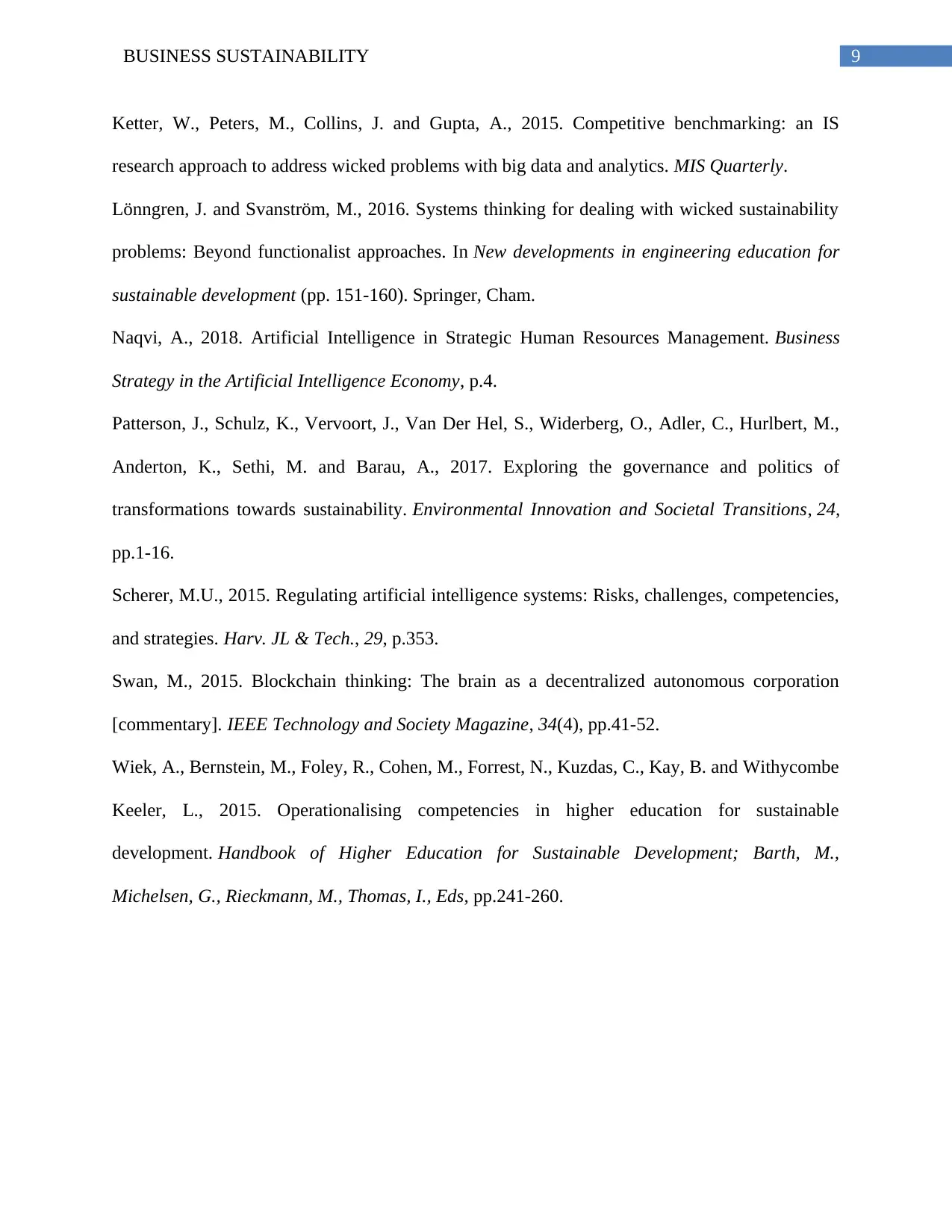
9BUSINESS SUSTAINABILITY
Ketter, W., Peters, M., Collins, J. and Gupta, A., 2015. Competitive benchmarking: an IS
research approach to address wicked problems with big data and analytics. MIS Quarterly.
Lönngren, J. and Svanström, M., 2016. Systems thinking for dealing with wicked sustainability
problems: Beyond functionalist approaches. In New developments in engineering education for
sustainable development (pp. 151-160). Springer, Cham.
Naqvi, A., 2018. Artificial Intelligence in Strategic Human Resources Management. Business
Strategy in the Artificial Intelligence Economy, p.4.
Patterson, J., Schulz, K., Vervoort, J., Van Der Hel, S., Widerberg, O., Adler, C., Hurlbert, M.,
Anderton, K., Sethi, M. and Barau, A., 2017. Exploring the governance and politics of
transformations towards sustainability. Environmental Innovation and Societal Transitions, 24,
pp.1-16.
Scherer, M.U., 2015. Regulating artificial intelligence systems: Risks, challenges, competencies,
and strategies. Harv. JL & Tech., 29, p.353.
Swan, M., 2015. Blockchain thinking: The brain as a decentralized autonomous corporation
[commentary]. IEEE Technology and Society Magazine, 34(4), pp.41-52.
Wiek, A., Bernstein, M., Foley, R., Cohen, M., Forrest, N., Kuzdas, C., Kay, B. and Withycombe
Keeler, L., 2015. Operationalising competencies in higher education for sustainable
development. Handbook of Higher Education for Sustainable Development; Barth, M.,
Michelsen, G., Rieckmann, M., Thomas, I., Eds, pp.241-260.
Ketter, W., Peters, M., Collins, J. and Gupta, A., 2015. Competitive benchmarking: an IS
research approach to address wicked problems with big data and analytics. MIS Quarterly.
Lönngren, J. and Svanström, M., 2016. Systems thinking for dealing with wicked sustainability
problems: Beyond functionalist approaches. In New developments in engineering education for
sustainable development (pp. 151-160). Springer, Cham.
Naqvi, A., 2018. Artificial Intelligence in Strategic Human Resources Management. Business
Strategy in the Artificial Intelligence Economy, p.4.
Patterson, J., Schulz, K., Vervoort, J., Van Der Hel, S., Widerberg, O., Adler, C., Hurlbert, M.,
Anderton, K., Sethi, M. and Barau, A., 2017. Exploring the governance and politics of
transformations towards sustainability. Environmental Innovation and Societal Transitions, 24,
pp.1-16.
Scherer, M.U., 2015. Regulating artificial intelligence systems: Risks, challenges, competencies,
and strategies. Harv. JL & Tech., 29, p.353.
Swan, M., 2015. Blockchain thinking: The brain as a decentralized autonomous corporation
[commentary]. IEEE Technology and Society Magazine, 34(4), pp.41-52.
Wiek, A., Bernstein, M., Foley, R., Cohen, M., Forrest, N., Kuzdas, C., Kay, B. and Withycombe
Keeler, L., 2015. Operationalising competencies in higher education for sustainable
development. Handbook of Higher Education for Sustainable Development; Barth, M.,
Michelsen, G., Rieckmann, M., Thomas, I., Eds, pp.241-260.
1 out of 10
Related Documents
Your All-in-One AI-Powered Toolkit for Academic Success.
+13062052269
info@desklib.com
Available 24*7 on WhatsApp / Email
![[object Object]](/_next/static/media/star-bottom.7253800d.svg)
Unlock your academic potential
Copyright © 2020–2025 A2Z Services. All Rights Reserved. Developed and managed by ZUCOL.




